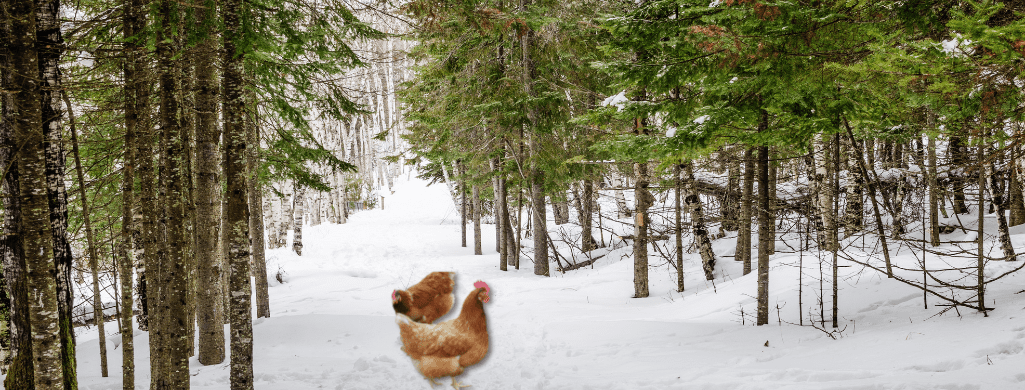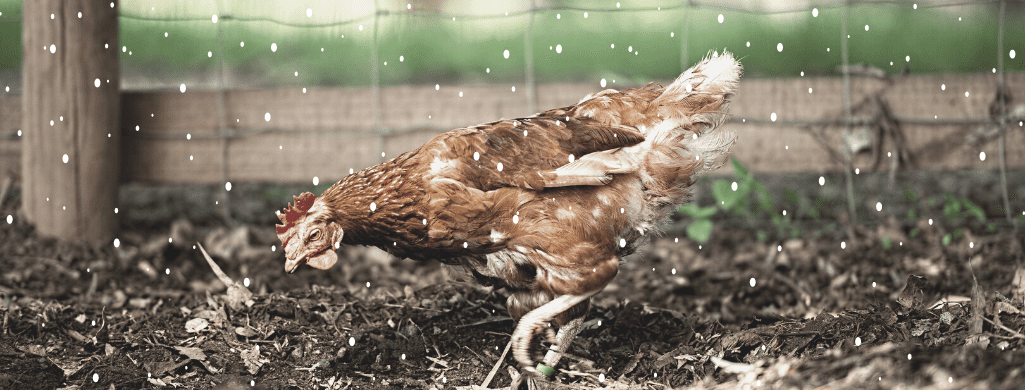Protecting your ISA Brown chickens from harsh winter temperatures is vital to their health.
Cold winds and winter precipitation are a recipe for upper respiratory illnesses and frostbite.
Baby chicks are extra sensitive to cold weather and must be kept in a warm shelter until their adult feathers grow in.
So, how cold can ISA Browns handle?
ISA Brown chickens can withstand winter temperatures at or slightly below 32° degrees Fahrenheit (0° C). If you keep your ISA Browns dry and provide them with a well-insulated chicken coop at night, they will not have issues surviving the winter.

Table of Contents
ToggleAre ISA Browns Cold Hardy?
ISA Browns are hardy birds able to withstand cold and hot temperatures.
Their medium-sized bodies are covered in downy feathers, which trap body heat in the winter and protect them from hot temperatures in the summer months.
Any chicken breed has difficulty staying warm when its feathers get wet. Wet feathers do not trap warm air against the body.
Further Reading: ISA Brown Chickens Molting & Feather Guide
Letting your chickens roam outside the coop prevents boredom and keeps the flock happy.
If snow is on the ground or there is rainy weather, you must ensure your ISA Browns are dry before placing them in the coop at night.
ISA Browns have a docile nature and enjoy cuddling with their owners. Wrapping them in a towel at the end of the day and drying their feathers is easy.
You must take special care with ISA Brown baby chicks.
Baby chicks cannot regulate their body temperature and lack protective body feathers for retaining warmth.
You must keep baby chicks in a warm brooder with a heat lamp. Once they develop insulating outer feathers and temperatures are above 65° degrees Fahrenheit (18° C), they may join the flock.
Read more about when ISA Brown chicks can go outside to make sure you don’t hurt them.
Are ISA Browns Prone to Frostbite?
Like other cold-weather chickens, ISA Browns have small, single combs.
Smaller combs and wattles are less prone to frostbite.
ISA Browns also do not have feathers on their legs and feet. This lack of feathers helps the legs and feet stay dry in the snow and rain.
In average winter temperatures, ISA Browns can spend ample time outdoors without worrying about frostbite.
During extreme winters, you must coat the comb and wattle with a layer of petroleum jelly. The petroleum jelly effectively prevents frostbite on combs and wattles.
When temperatures are well below freezing, limiting your chicken’s outdoor activity to short lengths of time is best.
Frostbite appears as black areas on the comb, wattle, or feet. If your ISA Browns have these black spots, you must increase blood flow to the area.
Increasing blood flow to frostbitten areas prevents the damage from spreading.
Wrap the bird in a towel and place a warm washcloth on the frostbitten area. Take care not to rub the comb and wattle as you do this.
Once blood flow to the area increases, keep your ISA Brown in a warm shelter for the rest of the day as the bird recovers.
How To Tell if Your ISA Browns Are Too Cold

When an ISA Brown is too cold, it puffs its feathers up. This traps warm air against the body, allowing the bird better body temperature regulation.
If your ISA Brown stands on one foot, the ground is too cold.
Chickens huddle against each for warmth in frigid temperatures.
When your flock spends most of the day in a huddle, it is too cold outside for them.
Since staying warm requires so much energy, your chickens may lose interest in eating and other everyday activities.
Only allow your chickens outside for short lengths of time when temperatures are this cold. Limiting outdoor time lets your ISA Browns conserve energy while still giving them time in the fresh air.
Constant confinement leads to boredom and fighting among the flock.
Further Reading: ISA Brown and Hyline Comparison
Do ISA Brown Hens Lay Eggs in the Winter?
The ISA Brown is a hybrid chicken raised for optimum egg production.
These prolific egg layers begin producing eggs at 22 weeks of age. An ISA Brown usually lays nearly 300 eggs per year, which equals about six eggs per week.
ISA Brown hens are not broody girls and usually lay lots of eggs year-round, even during the winter.
Since ISA Browns are such prolific layers, they have a much shorter lifespan than other chicken breeds.
The average lifespan of an ISA Brown is 2-5 years. Egg production starts declining when the hens are two years old.
Check out these other reasons ISA Browns stop laying eggs.
An ISA Brown raised in a backyard flock lives much longer than a chicken in a commercial egg-laying facility.
ISA Brown hens need a diet rich in protein and calcium. The extra nutrients replace what is lost during egg production and ensure healthy eggs.
If your ISA Brown stops laying all together, then it may be time to cull and butcher the fowl.
Further Reading: Can you eat ISA Brown chickens?
Protecting ISA Browns in the Winter

Even though ISA Browns are tolerant of cold temperatures, you must not leave them exposed to harsh winter weather.
All chickens need adequate protection against the cold to maintain good health.
There are several ways of protecting your flock against cold temperatures and wet conditions.
Keep Them Dry
Moisture is the biggest enemy of chickens during the winter months.
Keeping your ISA Browns dry prevents frostbite and illnesses like upper respiratory infections.
Add a layer of wood chips or pine pellets to the chicken run. This prevents puddles, so your chickens are not walking on wet ground.
If you get a lot of rain or snow in the winter, place a tarp over the chicken run, so the area stays dry.
Chickens do not always know when they should get out of the rain.
When rainfall is forecasted in your area, move your ISA Browns into the chicken coop.
Winterize the Chicken Coop
The main goal of winterizing the chicken coop is to keep moisture out and warm air in.
Do not make the coop airtight, as moisture still needs to escape.
Use insulation against the walls and seal small cracks and holes where drafts come in.
Leave the vent at the top of the coop uncovered for adequate ventilation. Without ventilation, moisture cannot evaporate, and ammonia builds up.
Avoid using a source of heat inside the coop. Fires from heat lamps and space heaters spread quickly through the dry straw in a chicken coop.
You do not want to risk this kind of danger.
The flock produces ample body heat to keep the chickens warm throughout the night.
Keep Their Environment Clean
Change the bedding in the coop and nesting boxes at least once weekly.
Moist bedding increases the risk of frostbite and causes ammonia buildup inside the coop.
A dirty environment is also a breeding ground for bacteria and mites taking shelter from the cold.
Improvise With a Greenhouse
A clever way to protect your ISA Browns in the winter is using a large greenhouse.
Placing a mobile coop or chicken tractor in the greenhouse gives your ISA Browns a better sense of security at night, but it isn’t necessary.
This helpful YouTube video shows how a greenhouse coop is created and offers helpful tips.
A greenhouse lets your chickens roam freely throughout the day, so they do not become bored or anxious.
The greenhouse also stays warmer and allows plant growth for your birds.
If you have the space for it, a greenhouse is an excellent place for your ISA Browns in the winter.
Don’t Leave Your ISA Browns Out in the Cold
ISA Browns are cold-hardy birds, but they need protection against harsh winter conditions.
While these chickens are not prone to frostbite, knowing what to do if they are is crucial.
Recognizing when your flock is too cold is also important for their health and well-being.
Give your ISA Browns a dry, clean shelter with some time outdoors to keep your chickens happy and healthy all winter.
How useful was this post?
Click on a star to rate it!
We are sorry that this post was not useful for you!
Let us improve this post!
Tell us how we can improve this post?
